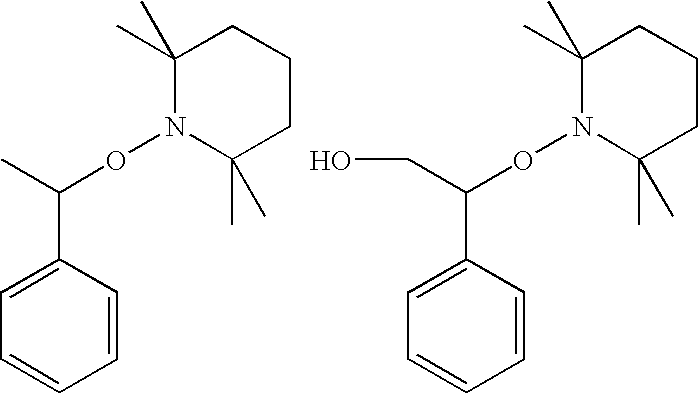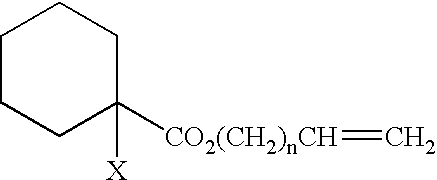Polymer and curable composition
a technology of acryloylterminated vinyl and polymer, which is applied in the direction of organic non-macromolecular adhesives, adhesives, etc., can solve the problems of high viscosity, difficult to introduce an alkenyl group into the terminal position of the polymer molecule without fail by such prior-art technology,
- Summary
- Abstract
- Description
- Claims
- Application Information
AI Technical Summary
Benefits of technology
Problems solved by technology
Method used
Image
Examples
example 1
Synthesis of Potassium Methacrylate
[0167]A flask was charged with methanol (800 mL) cooled to 0° C. Potassium t-butoxide (130 g) was added thereto in portions. While this mixture was maintained at 0° C., a methanolic solution of methacrylic acid (100 g) was added dropwise. After completion of dropwise addition, the temperature of the reaction system was raised from 0° C. to room temperature and the volatile fraction of the reaction mixture was distilled off under reduced pressure to recover potassium methacrylate of the following formula [hereinafter referred to as compound (1)].
CH2═C(CH3)CO2K
example 2
Synthesis of Potassium Acrylate
[0168]A flask was charged with methanol (500 mL) cooled to 0° C. Potassium t-butoxide (78 g) was added thereto in portions. While this mixture was maintained at 0° C., a methanolic solution of acrylic acid (50 g) was added dropwise. After completion of dropwise addition, the temperature of the reaction system was raised from 0° C. to room temperature and the volatile fraction of the reaction mixture was distilled off under reduced pressure to recover potassium acrylate of the following formula (hereinafter referred to as compound (2)].
CH2═CHCO2K
example 3
Synthesis of Methacryloyl-terminated Poly(n-butyl Acrylate))
[0169]Using copper (I) bromide as the catalyst, pentamethyldiethylenetriamine as the ligand, and diethyl 2,5-dibromoadipate as the initiator, n-butyl acrylate was polymerized to give a bromo-terminated n-butyl acrylate polymer having a number average molecular weight of 10900 and a molecular weight distribution of [Mw / Mn] ratio =1.12 (hereinafter referred to as polymer [1]). In N,N-dimethylacetamide was dissolved 20.0 g of the above polymer [1] followed by addition of 1.46 g of compound (1), and the mixture was stirred at room temperature for 2 days. This reaction mixture was diluted with ethyl acetate (50 mL) and filtered to remove the insoluble fraction. The filtrate was further diluted with ethyl acetate (150 mL) and washed with water and brine. The organic layer was dried over Na2SO4 and the volatile fraction was distilled off under reduced pressure to give a methacryloyl-terminated poly(butyl acrylate) (hereinafter ref...
PUM
| Property | Measurement | Unit |
|---|---|---|
| molecular weight distribution | aaaaa | aaaaa |
| molar ratio | aaaaa | aaaaa |
| temperature | aaaaa | aaaaa |
Abstract
Description
Claims
Application Information
 Login to View More
Login to View More - R&D
- Intellectual Property
- Life Sciences
- Materials
- Tech Scout
- Unparalleled Data Quality
- Higher Quality Content
- 60% Fewer Hallucinations
Browse by: Latest US Patents, China's latest patents, Technical Efficacy Thesaurus, Application Domain, Technology Topic, Popular Technical Reports.
© 2025 PatSnap. All rights reserved.Legal|Privacy policy|Modern Slavery Act Transparency Statement|Sitemap|About US| Contact US: help@patsnap.com



